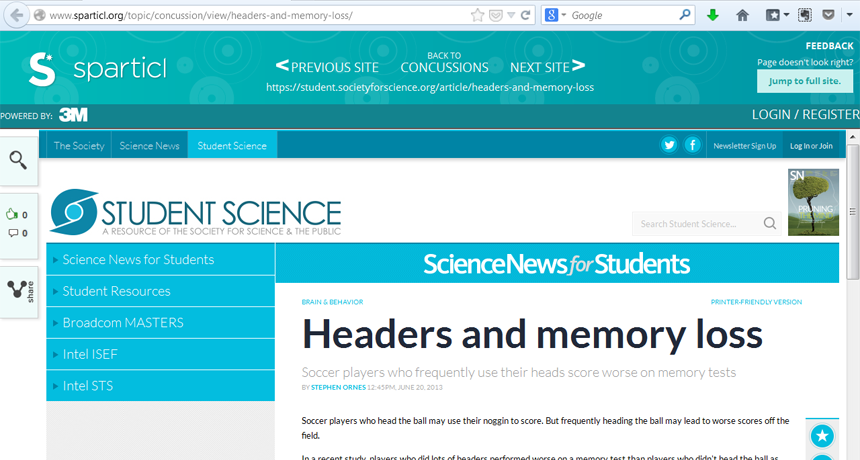Sparticl: Finding good science on the web

Sparticl aggregates articles on science from all over the web, including Science News for Students.
Sparticl.org
Where do you search for information about science?
If you’re a student in middle school or high school, hopefully you’ll check out our websites — Science News for Students and Science News. But they may not offer everything you need. So maybe you will check out Wikipedia. But not all Wikipedia articles are easy to follow. Their language can prove challenging even to some scientists. And people who post on Wikipedia don’t have to be experts, or even to know anything about the topic. So its material may not always be accurate. Other sites may have a bias. For instance, some sites may challenge whether evolution exists (it does) or whether humans have any impact on global climate (they do).
So when surfing the Internet, how do you know where to find reliable science information that you also can understand? A Minnesota-based TV producer — Twin Cities Public Television — has stepped in to help. It has created a site to help students find information in Science, Technology, Engineering and Mathematics (the so-called STEM fields). With funding from 3M, they created Sparticl. This website finds publicly available articles from STEM sources around the Web and provides direct links to them. They also augment some of the articles with quizzes and sometimes with glossaries that make them easier to understand.
Say you want to learn about aardvarks. Go to Sparticl, find the search box and type in aardvark. From there you’ll find links to information on this mammal at sites ranging from the BBC to the Wildlife Conservation Society. In other sections, you can test your knowledge of enzymes, watch videos or play science games.
And Sparticl offers more than just “information.” By registering on the site, you can vote on whether you like an offering (by giving it a thumbs-up or -down). You also can request material on new topics, offer comments and rack up points by playing those science games. The site is designed for teens (who can even sign in from Facebook).
The makers of Sparticl got their idea for the new site by looking at the National Science Digital Library. That’s an online collection of educational material for teachers. Richard Hudson directs science production at Twin Cities Public Television. He and Sparticl’s other developers realized that there was plenty of STEM information available for teachers — but not teens. Search engines do not always answer students’ needs. He says this means that “for students, searching for STEM content is too hard.”
The new website focuses on meeting the needs of students in grades 7 to 9. This is a critical time when teens might lose interest in science, Hudson says. It’s also a time when kids tend to become active on social media.
The new website tapped students for guidance. The Teen Advisory Board it created included students interested in STEM fields. Many have even participated in competitions like the Broadcom MASTERS. The advisory board helped the site’s designers learn what kids want and need.
Sparticl appears off to a good start. Since it launched six weeks ago, people have viewed the site more than 150,000 times.
Sparticl does not yet have a readability index. Such an index rates the minimum grade at which students should be able to understand a story. (For instance, all stories on Science News for Students are written with a vocabulary accessible to students in grades 6 through 8.) Because Sparticl doesn’t use such a rating, Hudson says it uses computer software to search the Internet for science articles that should prove suitable for teens. Then editors look at what the computer turns up and picks a diverse selection. In the end, Hudson notes, “Human editors make the judgment call.”
But be forewarned: Some of those judgment calls result in links to adult stories. And these may have appropriate content, they may still prove a tough read for many students. For instance, NPR’s story on the Higgs boson comes in at a readability score of about 11th grade. By contrast, a feature explaining the discovery of this long-sought particle in Science News for Students has a 7th grade readability.
In the long run, Hudson hopes that Sparticl will have a big impact. “What we hope it will do is invite more students into STEM,” he says. “Students who are on the fence and might be turned away will find that Sparticl changes their mind.” Sparticl plans to conduct studies to measure how effective the site is. For now, it is still amassing links to a wealth of articles on a broad range of topics.
Where do you go for student-appropriate science on the web? Please share your findings with us and other educators.